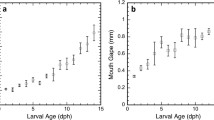Abstract
Experimental studies of feeding on zooplankton often involve the use of non-evasive Artemia spp. to represent zooplanktonic prey. Some zooplankton, however, such as copepods, are potentially evasive due to possession of effective predator-avoidance mechanisms such as high-speed escape swimming. In the present study, we compared the efficiencies with which non-evasive (A. salina) and evasive (copepods) zooplankton were captured by a sessile, suspension feeder, the coral-inhabiting barnacle Nobia grandis (Crustacea, Cirripedia). N. grandis specimens and zooplankton used in the present study were collected near Eilat, Israel in 1993. The effect of different flow speeds (from 0 to 14 cm s-1) on captures of the two preys was also investigated. Additionally, we examined the effect of a flow-induced barnacle behavioral switch from active to passive suspension feeding, on zooplankton capture. Two video cameras were used to make close-up, three dimensional recordings of predator-prey encounters in a computer-controlled flow tank. Frame-by-frame video analysis revealed a highly significant difference (P< 0.001) in the efficiency with which A. salina and copepods were caught (A. salina being much more readily captured than copepods). After an encounter with cirri of feeding barnacles, copepods were usually able to swim out of the barnacles capture zone within one video frame (40 ms), by accelerating from a slow swimming speed (approximately 1.85 cm s-1) to a mean escape swimming speed of 18.11 cm s-1 (ca. 360 body lengths s-1). This was not the case for A. salina nauplii, which usually remained in contact with cirri before being transferred to the mouth and ingested. Thus, experimental studies addressing the methodology of organisms feeding on zooplankton should consider that slow-swimming prey like Artemia sp. nauplii may only represent the non-evasive fraction of natural mesozooplankton assemblages.
Similar content being viewed by others
References
Anderson DT, Southward AJ (1987) Cirral activity of barnacles. In: Southward AJ (ed) Crustacean issues 5. Biology of barnacles. Balkema, Rotterdam
Batty RS, Blaxter JS, Libby DA (1986) Herring (Clupea harengus) filter-feeding in the dark. Mar Biol 91:371–375
Confer JL, Blades PI (1975) Omnivorous zooplankton and planktivorous fish. Limnol Oceanogr 20:571–579
Coughlin DJ, Strickler JR (1990) Zooplankton capture by a coral reef fish: an adaptive response to evasive prey. Envir Biol Fish 29: 35–42
Crisp DJ, Southward AJ (1961) Different types of cirral activity of barnacles. Phil Trans R Soc Lond 243:271–308
Drenner RF, Strickler JR, O'Brien WJ (1978) Capture probability: the role of zooplankter escape in the selective feeding of planktivorous fish. J Fish Res Bd Can 35:1370–1373
Georgian T, Thorp JH (1992) Effects of microhabitat selection on feeding rates of net spinning caddisfly larvae. Ecology 73:229–240
Haury LR, Kenyon DE, Brooks JR (1980) Experimental evaluation of the avoidance reaction of Calanus finmarchius. J Plankton Res 2:187–202
Lagziel A (1992) Influence of feeding on metabolism and calcification of two hermatypic corals. MS Thesis. Hebrew University of Jerusalem, Jerusalem
McComas SR, Drenner RW (1982) Species replacement in a reservoir fish community: silverside feeding mechanics and competition. Can J Fish aquatic Sciences 39:815–821
Motta PJ (1982) Functional morphology of the head of the inertial suction feeding butterflyfish Chaetodon miliaris (Perciformes, Chaetodontidae). J Morph 174:283–312
Muscatine L, Falkowski PG, Dubinsky Z, Cook PA, McCloskey LR (1989) The effect of external nutrient resources on the population dynamics of zooxanthellae in a reef coral. Proc R Soc Lond 236:311–324
Renon JP (1977) Zooplankton du lagon et des abords exterieurs de l'atoll de Moruroa. Annls Inst océanogr, Paris 53:217–236
Shimeta J, Jumars PA (1991) Physical mechanisms and rates of particle capture by suspension-feeders. Oceanogr mar Biol A Rev 29:191–257
Singarajah KV (1969) Escape reactions of zooplankton: the avoidance of a pursuing siphon tube. J exp mar Biol Ecol 3:171–178
Smith MFL, Warburton K (1992) Predator shoaling moderates the confusion effect in blue-green chromis Chromis viridis. Behavl Ecol Sociobiol 30: 103–107
Sorokin YI (1990) Plankton in the reef ecosystems. In: Dubinsky Z (ed) Ecosystems of the world 25. Coral reefs. Elsevier, New York
Sokal RR, Rohlf FJ (1981) Biometry. Freeman, San Francisco
Strickler JR (1975) Swimming of planktonic Cyclops species (Copepoda, Crustacea): pattern, movements and their control. In: Wu TY-T, Brokaw CJ, Brennan C (eds) Swimming and flying in nature, Vol 2. Plenum Press, New York
Strickler JR, Bal AK (1973) Setae of the first antennae of the copepod Cyclops scutifer (Sars): their structure and importance. Proc natn Acad Sci USA 70:2656–2659
Trager GC, Coughlin D, Genin A, Achituv Y, Gangopadhyay A (1992) Foraging to the rhythm of ocean waves: porcelain crabs and barnacles synchronize feeding motions with flow oscillations. J exp mar Biol Ecol 164:73–86
Trager G, Hwang J-S, Strickler JR (1990) Barnacle suspension-feeding in variable flow. Mar Biol 105:117–127
Vinyard GL (1982) Variable kinematics of Sacramento perch (Archoplites interruptus) capturing evasive and nonevasive prey. Can J Fish aquat Sciences 39:208–211
Winer BJ (1971) Statistical principles in experimental design. McGraw-Hill Co, New York
Wright DI, O'Brien WJ (1984) The development and field test of a tactical model of the planktivorous feeding of white crappie (Poxomis annularis). Ecol Monogr 54:65–98
Yen J, Fields D (1992) Escape responses of Acartia hudsonica (Copepoda) nauplii from the flow field of Temora longicornis (Copepoda). Abstracts of the American Society of Limnology and Oceanography Aquatic Sciences Meeting, February, Santa Fe, New Mexico. American Society of Limnology and Oceanography, Inc, Lawrence
Yufera M, Rodriguez A (1987) Aspectos metodologicos sobre el calculo de las tasas de consumo de alimento en larvas de decapodos. Investigación pesq 51:561–569
Author information
Authors and Affiliations
Additional information
Communicated by O. Kinne, Oldendorf/Luhe
Rights and permissions
About this article
Cite this article
Trager, G., Achituv, Y. & Genin, A. Effects of prey escape ability, flow speed, and predator feeding mode on zooplankton capture by barnacles. Marine Biology 120, 251–259 (1994). https://doi.org/10.1007/BF00349685
Received:
Accepted:
Issue Date:
DOI: https://doi.org/10.1007/BF00349685




